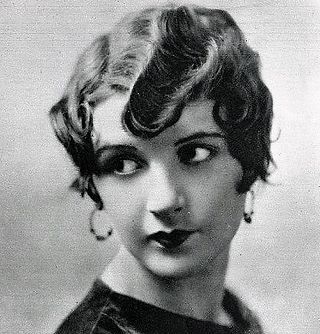
Ann Harding was an American theatre, motion picture, radio, and television actress. Harding was a regular on Broadway and on tour in the 1920s. In the 1930s Harding, was one of the first actresses to gain fame in the new medium of "talking pictures," and she was nominated for the Academy Award for Best Actress in 1931 for her work in Holiday.
Connie Douglas Reeves was believed to be America's oldest cowgirl.

Jean Rogers was an American actress who starred in serial films in the 1930s and low–budget feature films in the 1940s as a leading lady. She is best remembered for playing Dale Arden in the science-fiction serials Flash Gordon (1936) and Flash Gordon's Trip to Mars (1938).

Jane Withers was an American actress and children's radio show hostess. She became one of the most popular child stars in Hollywood in the 1930s and early 1940s, with her films ranking in the top ten list for box-office gross in 1937 and 1938.

Betty Jane Bierce, better known by her stage name Jane "Poni" Adams, was an American actress in radio, film, and television in the 1940s and 1950s.

Oona O'Neill, Lady Chaplin was a Bermudian-born actress, the daughter of Irish-American playwright Eugene O'Neill and English-born writer Agnes Boulton, and the fourth and last wife of actor and filmmaker Charlie Chaplin.

Helen Virginia Parrish was an American stage and film actress.

Barbara Bedford was an American actress who appeared in dozens of silent movies. Her career declined after the introduction of sound, but she continued to appear in small roles until 1945.

Sally Phipps was an American actress.

Marcia Mae Jones was an American film and television actress whose prolific career spanned 57 years.
Thomas Jefferson High School is a public high school in San Antonio, Texas and is one of ten high schools in the San Antonio Independent School District. Completed in 1932 at a cost of $1,250,000, it was the third high school built in the city. During 2022–2023, Jefferson High School had an enrollment of 1,686 students and a student to teacher ratio of 14.40. The school received an overall rating of "B" from the Texas Education Agency for the 2021–2022 school year.

The Holy Terror is a 1937 American comedy drama film directed by James Tinling as a vehicle for child star Jane Withers. The film follows the comic adventures of 11-year-old Withers as she causes mild havoc and catches spies on her father's naval base.

Shooting High is a 1940 American Western film directed by Alfred E. Green and starring Jane Withers, Gene Autry, and Marjorie Weaver. Written by Lou Breslow and Owen Francis, the film is about a generations-old feud between two families. This feud is revived when the town banker tries to construct a highway through the area where a monument is installed to the frontiersman ancestor of one of the families.

Carol Hughes was an American actress. She is best remembered for her leading roles opposite Gene Autry and Roy Rogers, and for her role as Dale Arden in Flash Gordon Conquers the Universe (1940).

Paddy O'Day is a 1936 American comedy drama film directed by Lewis Seiler and released by 20th Century Fox. It stars Jane Withers, Pinky Tomlin, and Rita Hayworth. The story follows the adventures of a plucky Irish girl who arrives at Ellis Island only to discover that her mother, a cook in a wealthy Long Island home, has died. Hiding from the immigration officers who want to deport her, she charms everyone she meets, including the service staff and reclusive young master of the house. She goes to live with a family of Russian dancers that she met on the ship, and performs with them in their nightclub. Withers uses a heavy Irish brogue for her character and sings one song with an Irish accent and another song with a Russian accent. She also dances in several numbers, while Hayworth performs a traditional Russian dance in a nightclub revue.

Youth Will Be Served is a 1940 American musical film directed by Otto Brower and starring Jane Withers and Jane Darwell.

Ginger is a 1935 American comedy-drama film directed by Lewis Seiler and written by Arthur Kober. The film stars Jane Withers as her first starting role, O. P. Heggie, Jackie Searl, Katharine Alexander, and Walter Woolf King.

Jane Florence Benitez de Leon is a Filipino actress, commercial model and philanthropist. She began her acting career after signing up with Star Magic in 2015. She initially played minor roles in films, made several appearances in drama anthologies and eventually landed supporting roles in Halik (2018) and Ang Probinsyano (2021). Her breakthrough came following her portrayal of the titular role in the series Mars Ravelo's Darna (2022). She has received two nominations from PMPC Star Awards for Television for her performances in two Maalaala Mo Kaya episodes: Medal and Doctor Hero.
Adele Lacy was an American film actress whose films all appeared during the Great Depression. Her name was sometimes spelled Adele Lacey.

Irene Morra was an American film editor who had a 30-year career in Hollywood beginning during the silent era. She cut a number of films by director David Butler.


















